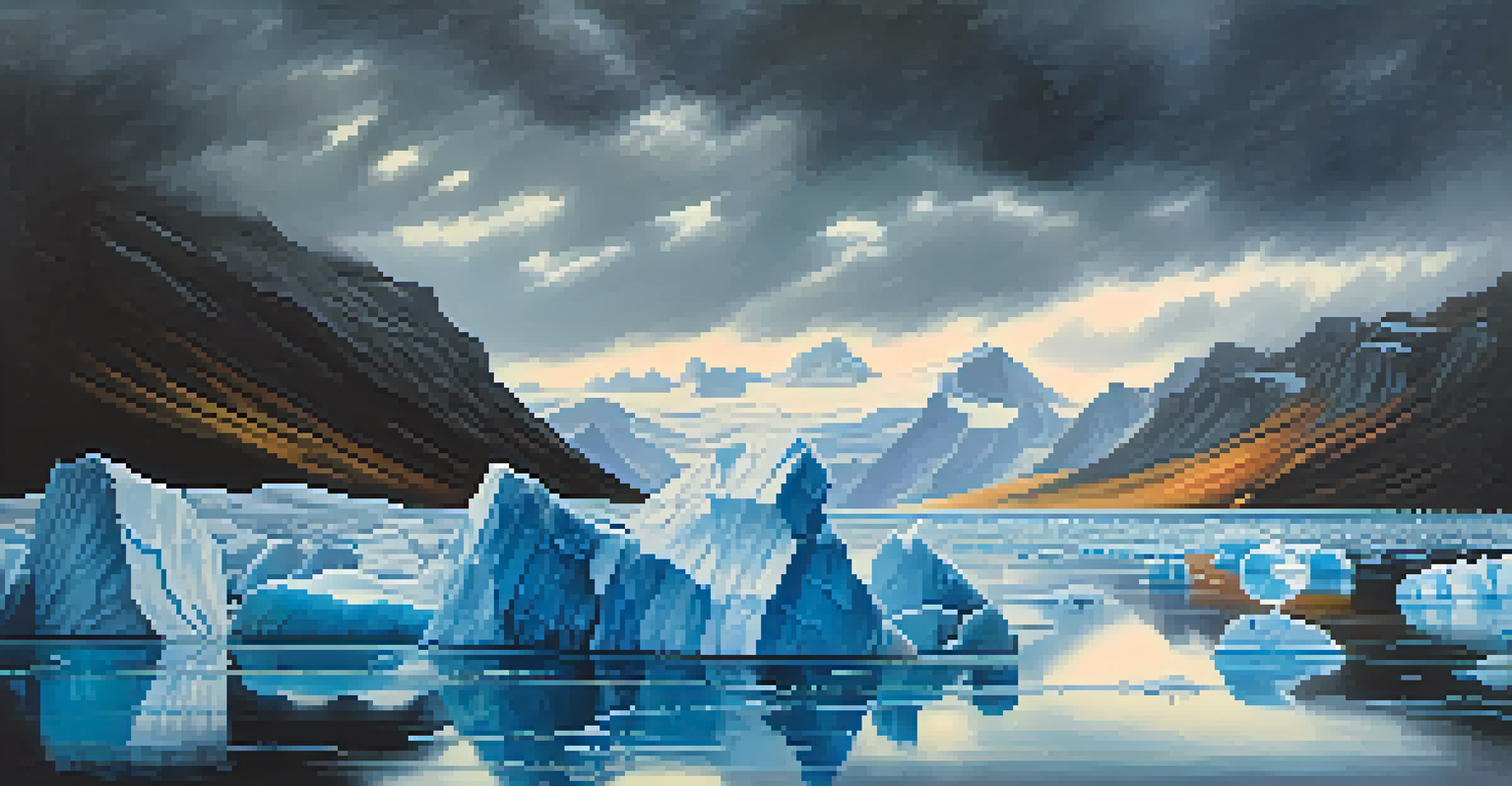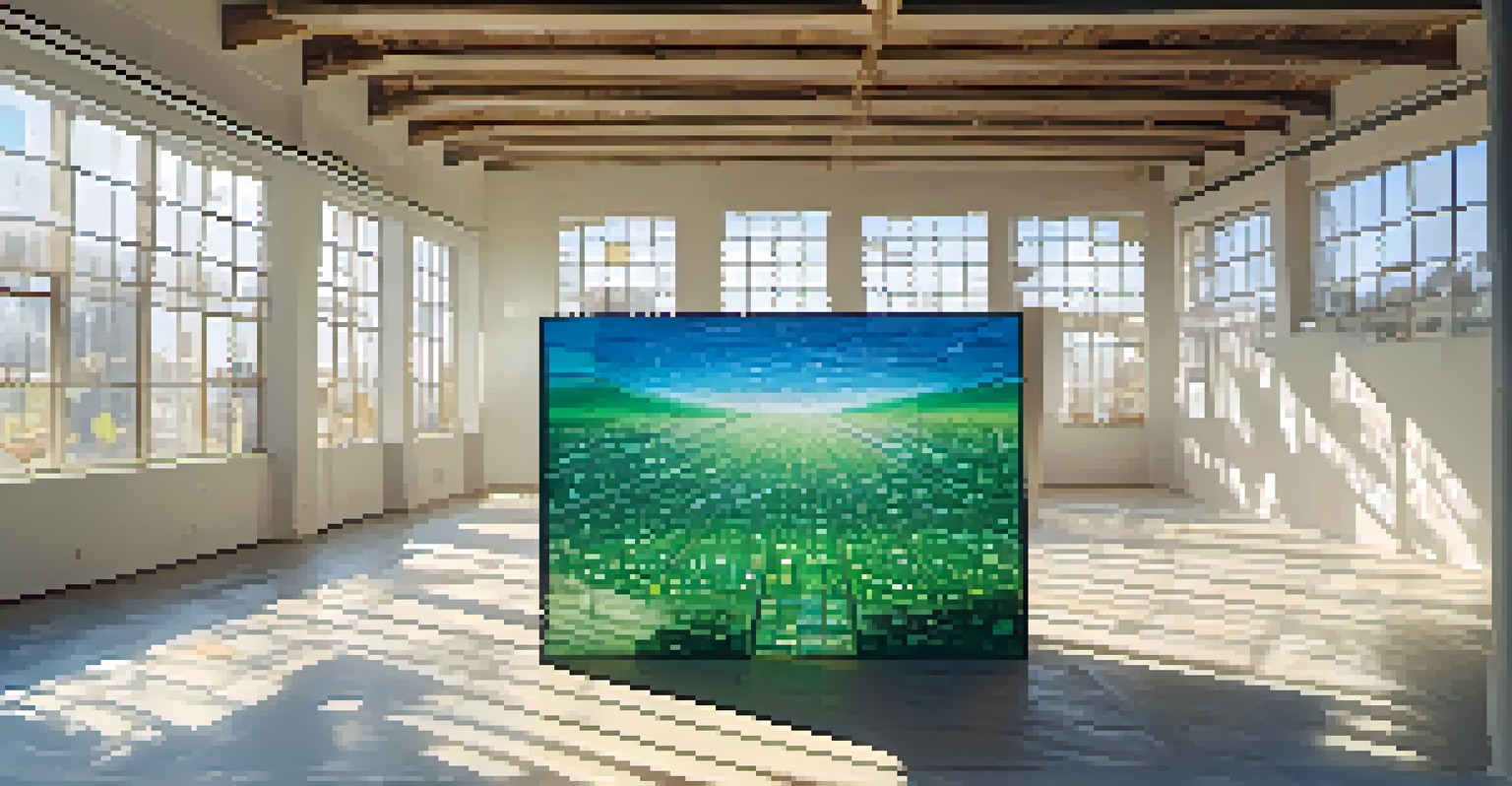The Influence of Climate Change on Contemporary Art Styles

Understanding Climate Change: A Brief Overview
Climate change refers to long-term shifts in temperatures and weather patterns, primarily caused by human activities like burning fossil fuels. These changes have far-reaching effects on our planet, influencing not just ecosystems but also cultural expressions. As artists grapple with these realities, their work often reflects both the urgency and the complexity of climate issues.
Art is not a mirror to hold up to society, but a hammer with which to shape it.
For instance, rising sea levels and extreme weather events are not just environmental concerns; they also inspire a new wave of artistic exploration. Artists are using their platforms to provoke thought and raise awareness about these pressing issues, often sparking conversations that extend beyond the art world. This intersection of art and environmentalism is becoming increasingly important in contemporary discourse.
By understanding the fundamentals of climate change, we can better appreciate how these pressing issues are woven into the fabric of modern art. This context sets the stage for exploring specific artistic movements and styles that have emerged as a response to our changing world.
How Climate Change Inspires Environmental Art
Environmental art is a genre that directly addresses ecological issues, often using natural materials or landscapes as part of the artistic process. Artists in this field aim to raise awareness about environmental degradation and inspire action through their work. For example, artists like Andy Goldsworthy create stunning installations using natural elements, effectively merging art with nature's beauty while highlighting its fragility.

Many contemporary artists are now incorporating climate change themes into their creations, using visual storytelling to reflect on humanity's impact. These works often provoke strong emotional responses, encouraging viewers to consider their role in the environmental crisis. By engaging with these artworks, audiences can gain a deeper understanding of the stakes involved in climate change.
Art Reflects Climate Change Issues
Artists are increasingly using their work to address the complexities and urgency of climate change, bridging the gap between environmentalism and creative expression.
Through environmental art, artists not only convey the urgency of climate issues but also provide hope and solutions, fostering a sense of community and shared responsibility. This poignant blend of creativity and activism illustrates how art can serve as a catalyst for change.
The Role of Digital Art in Climate Advocacy
Digital art has emerged as a powerful medium for climate advocacy, leveraging technology to reach wider audiences. Artists are using virtual platforms to create immersive experiences that highlight the stark realities of climate change. For instance, augmented reality can transport viewers to melting glaciers or deforested landscapes, providing a visceral understanding of these issues.
The best way to predict the future is to create it.
Social media also plays a crucial role in disseminating digital art, enabling artists to share their work and messages instantly. Campaigns that utilize striking visuals have the potential to go viral, raising awareness and prompting discussions about climate action. This accessibility allows for a more inclusive dialogue around environmental issues, inviting diverse perspectives into the conversation.
By harnessing the capabilities of digital art, creators can effectively bridge the gap between art and activism, fostering a sense of urgency and responsibility among viewers. This innovative approach highlights the transformative power of technology in addressing global challenges.
Sustainable Practices in Art Creation
As artists become more aware of their environmental footprints, many are adopting sustainable practices in their work. This shift includes using eco-friendly materials, reducing waste, and embracing renewable resources. For example, some artists now create works from repurposed materials, transforming discarded items into meaningful art pieces.
Sustainable art not only minimizes environmental impact but also serves as a commentary on consumerism and waste culture. By showcasing the beauty and potential of recycled materials, artists challenge viewers to reconsider their consumption habits. This approach encourages a dialogue about sustainability, pushing the boundaries of what art can signify in our modern world.
Digital Art Enhances Climate Advocacy
The rise of digital art allows creators to leverage technology for immersive experiences that raise awareness about climate change and engage a wider audience.
Moreover, these eco-conscious methods inspire a new generation of artists to think critically about their practices. As sustainability becomes a focal point in contemporary art, it fosters a deeper connection between the work and the environment it represents.
Art as a Reflection of Climate Anxiety
Climate anxiety is a growing phenomenon, as many individuals grapple with feelings of helplessness in the face of environmental crises. Artists are increasingly channeling this anxiety into their work, reflecting the emotional turmoil that climate change evokes. Through various mediums, they articulate fears, hopes, and the desire for change, making the invisible visible.
For instance, installations that depict dystopian futures or the devastation of natural landscapes can provoke strong emotional responses, urging audiences to confront uncomfortable truths. These works serve as a mirror, reflecting society's collective concerns while simultaneously prompting action. By engaging with these themes, artists create a space for dialogue and reflection.
This emotional connection to climate change through art allows viewers to process their feelings and consider their roles in addressing these challenges. In this way, art becomes a powerful vehicle for expressing and alleviating climate anxiety.
Collaborations Between Artists and Scientists
The collaboration between artists and scientists is becoming increasingly common as both fields recognize the importance of interdisciplinary dialogue. These partnerships often yield innovative projects that merge scientific research with artistic expression, creating impactful works that inform and engage audiences. For example, artists may use scientific data to create visual representations of climate trends, making complex information more accessible.
Such collaborations not only enhance the artistic process but also promote a greater understanding of climate science. By translating data into compelling visuals, artists can convey critical messages about climate change in ways that resonate with the public. This synergy fosters a holistic approach to environmental issues, where art and science work hand in hand.
Sustainability Shapes Artistic Practices
Many artists are adopting sustainable practices in their work, using eco-friendly materials and repurposed items to challenge consumerism and promote environmental consciousness.
Through these partnerships, artists and scientists can inspire action and advocacy, encouraging individuals to engage with climate issues on a deeper level. Together, they illuminate the intertwined nature of art and science in addressing global challenges.
The Future of Art in a Changing Climate
As climate change continues to affect our world, the role of art in society will likely evolve. Artists will increasingly respond to environmental challenges, creating works that reflect the urgency of the situation while inspiring hope and resilience. This dynamic landscape will foster a diversity of voices, showcasing a wide range of perspectives on climate issues.
The future of contemporary art may also see a rise in participatory and community-driven projects, empowering individuals to contribute to the dialogue. By engaging local communities in artistic endeavors, artists can create a sense of ownership and collective responsibility for environmental stewardship. This collaborative approach enhances the impact of art in addressing climate change.

Ultimately, the influence of climate change on contemporary art styles will continue to deepen, shaping not only the artworks we encounter but also the conversations we have. As we navigate this changing climate, art will remain a vital force for reflection, action, and hope.